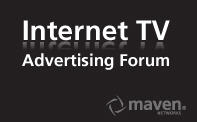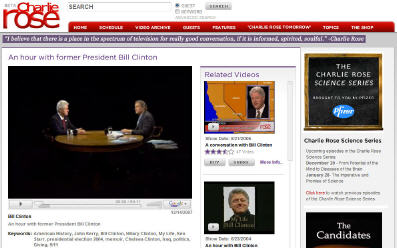-
Signiant: Plumber for Broadband Video Era
As many of you know, business development executives (and CEOs!) tend to be guilty of "throwing completed deals over the wall", expecting operations people and developers to implement as intended, while they move on to do the next deal. I know this first-hand as I was a biz dev guy for many years!
Yet, as I learned over many years and with multiple companies, each and every deal comes with its own particular implementation characteristics. These include things like multiple formats, encoding rates, business rules, file transfer processes, approvals and so forth. Do enough deals and pretty soon you've introduced massive complexity into your organization involving tons of manual tasks and costs which can quickly erase any profitability the underlying deal assumed.
This is where a company named Signiant comes into play. They're a sort of "plumber for the broadband video era." This unglamorous-sounding description does them no injustice; just think for a moment what the world would be like without actual plumbing, and you then you'll begin to appreciate how important the role
 is that Signiant plays in powering broadband video. The executive team includes a number of ex-Avid people, who bring a valuable perspective to the challenges of broadband video distribution. And as the broadband video market matures further and a spiraling number of deals get done, the plumbing to move all this video around only becomes more complex.
is that Signiant plays in powering broadband video. The executive team includes a number of ex-Avid people, who bring a valuable perspective to the challenges of broadband video distribution. And as the broadband video market matures further and a spiraling number of deals get done, the plumbing to move all this video around only becomes more complex. Last week I caught up with Tony Lapolito, Signiant's VP of Marketing who shared the company's strategy and product details. While the company's been around for over 10 years (staring as an internal project at Nortel), it has only identified the media industry as a key vertical focus in the last 2 years. It has quickly won respect, working with marquee customers like NBC, Disney, BT and just yesterday announcing a deal with Current.
Signiant brings an enterprise orientation to broadband video delivery, considering itself a "digital media supply chain" company. This may be unfamiliar territory for some of you, so to boil it down, the point of Signiant is to ensure that desired content is where it needs to be, when it needs to be there, and delivered with maximum efficiency, least cost and highest security/reliability. Below is a basic diagram depicting how Signiant works.

Signiant allows users to set up work flow processes to automatically handle a wide range of tasks. For example, NBC currently uses Signiant to securely distribute its content to approximately 20 partners following business rules for each. Tony said NBC expects its partnership roster to rise to 200 in the next 2 years and that Signiant will allow it to scale by allowing easy configuration of the content distribution process and business rules for each of these new deals.
Signiant does a lot of other things, such as prioritizing and allocating bandwidth, tracking all digital assets and managing approvals, all while tying into existing digital asset management systems and other legacy platforms in use. For Current, Signiant is streamlining the process of uploading viewer-created content, allowing Current to more quickly collect, approve and post inbound video.
There's not enough space to get into further detail, but suffice to say, if your operation is already groaning under the weight of implementing myriad deals, and/or you're pursuing a distribution-centric business strategy for your broadband video assets, it's well worth understanding the technology and business case behind Signiant.
Categories: Technology
Topics: Signiant
-
Charlie Rose Video Delivery Not Ready for Prime-Time
Last night I had a first-hand experience about why high-quality video delivery matters so much.
As an admitted political junkie, I just HAD to see the replay of Charlie Rose's interview with Bill Clinton from Friday night. I'd read that Clinton's handlers were apoplectic behind the scenes, asking for the interview to be terminated early because Clinton had become so agitated under Rose's relentless questioning. Clinton was getting frustrated that he just couldn't quite articulate why Hillary is best-suited to the role, or why Barack Obama is unqualified.
Ok, so credit to Charlie Rose that the full episode was offered (commercial free btw, this being PBS), and that it was highlighted right at the top of the home page. But that's about the only thing right about the experience. No exaggeration, the video probably hung at least 20 times and completely failed at least half a dozen times. It ranked as one of the worst broadband video experiences I've had in recent memory.
That said, I stayed with it the entire way, because how else would I get to see the episode? However, only a tiny fraction of viewers would be as patient as I was in this situation, even despite the fact that the site still says "beta."
So memo to all content providers: if you're going to put your top assets and talent online, make sure you have a quality delivery infrastructure in place to do them justice and please your fans. Second chances are hard to come by in the online world.
Categories: Broadcasters
Topics: Charlie Rose, PBS
-
Move Networks $40.1M Round Could Increase, '08 Expansion Planned
Move Networks, which quietly closed on a recent $40.1 million second round, may expand it further pending diligence being conducted by one more investor. Move CEO John Edwards shared the information with me in a briefing. The company still hasn't officially announced the round or its participants. John did say they're mainly strategic investors and the official word should come in a couple of weeks. The funding comes on top of its $11.3 million first round announced in February '07.
 Move is focused on high-quality broadband video delivery, especially for long-form content, and optimizing the user experience. It is clearly gaining traction with both customers (e.g. Disney, Fox, CW, Discovery, etc.) and users. Move's client runs its proprietary adaptive "stream selection protocol", which dynamically detects the user's bandwidth and CPU, thereby optimizing the video experience. This leads to low video stall-out or re-buffering incidents, which Move believes is the #1 cause for terminating video sessions.
Move is focused on high-quality broadband video delivery, especially for long-form content, and optimizing the user experience. It is clearly gaining traction with both customers (e.g. Disney, Fox, CW, Discovery, etc.) and users. Move's client runs its proprietary adaptive "stream selection protocol", which dynamically detects the user's bandwidth and CPU, thereby optimizing the video experience. This leads to low video stall-out or re-buffering incidents, which Move believes is the #1 cause for terminating video sessions.John shared a few interesting statistics. Its customers have delivered Move-powered video to a cumulative 27 million users since March '07. Using its client, Move can track all manner of user behavior including time spent with the selected video. This yields another stat: for a single one hour episode delivered, approximately 60% watch longer than 30 minutes, with an average session length of 53 minutes.
Demonstrating that it can deliver higher-quality video and consistently longer viewing is at the heart of Move's value proposition, as it allows content providers to sell more ad inventory, driving top line revenue and ROI. Move also offers an ad module, allowing improved targeting and insertion of flexible cue points based on user behaviors plus a drag-and-drop syndication feature. The company also focuses on reducing customer expenses by optimizing delivery over multiple CDNs and augmenting this with a peer-sharing capability.
Move has a lot on its plate going into '08. John says they are running projects with all the major networks, are supporting all the live streaming for the Olympics plus lots of other live event broadcasts, rolling out integrations with set-top boxes and expanding internationally with new offices in Europe and Asia.
Categories: Technology
Topics: CW, Discovery, Disney, FOX, Move Networks
-
Quarterlife's Herskovitz Interviewed on NPR
Driving home yesterday I caught a pretty interesting interview on NPR with Quarterlife's co-creator Marshall Herskovitz. It's only about 15 minutes, but the last 1/3 is quite insightful as Herskovitz expounds on the
 problems with today's Hollywood system and what he and partner Edward Zwick are doing with Quarterlife and NBC. You can listen to it here.
problems with today's Hollywood system and what he and partner Edward Zwick are doing with Quarterlife and NBC. You can listen to it here.Categories: Broadcasters, Indie Video
Topics: NBC, Quarterlife
-
Dell and Gap Use Divergent Video Holiday Campaigns
Here's more evidence that brand marketers are thinking progressively about how to leverage broadband video to get consumers to connect with their brands and drive sales. Today's examples are holiday campaigns from Dell and Gap.
By far the more unconventional of the two is Dell's initiative, which resides under the separate brand "YoursIsHere." It's a kooky, yet clever mini-site that opens with Burt Reynolds giving you a quickie explanation of how the site works.
Basically you select a product or products you're interested in receiving for the holidays and then enlist one of 6 celebrities (e.g Reynolds, Brooke Burke, Ice T, Estelle Harris, etc.) to make an email video pitch to your friends and family on your behalf (Dell calls this "Star Power"). Dell's taken the extra step of integrating with 4 big email providers so you can easily access your address books. You can even use PayPal if you want to "pass the virtual hat" collecting cash instead.
I chose a digital camera and Brooke. The video is here. It's engaging in a random sort of way ("You've caught me relaxing with my bunny rabbits." Huh?) I could quibble with some of the details of how Dell's executed the campaign, starting with the fact that the site doesn't let me narrow my choice between a digital camera, GPS or digital music player, but I won't. I give Dell lots of points for thinking way outside the box for how to use video. Somebody in Dell marketing went far out on a limb in suggesting YoursIsHere and someone else even further in approving it. Hopefully solid sales will result and that limb won't snap under them!
On the other hand, Gap's initiative, "GapTidings.com," produced with Yahoo, is more conventional, but it definitely requires more work by the user. First off, it requires a little UGC ingenuity to capture yourself giving your video greeting. Then you need to upload it, personalize it and send it to your friends and family. Gap surrounds the greeting with its branding. It's a less bold play than Dell's, but still gives users a nice opportunity to participate, while affiliating with the Gap brand.
These marketing initiatives come on the heels of lots of others, some of which I described in this earlier post. I see no end in sight. Marketers are quickly embracing broadband video, which provides engagement opportunities never before available. I'm betting the upcoming Super Bowl will be a big-time showcase for more of these broadband initiatives.
Categories: Brand Marketing, UGC
-
5 Conclusions from Broadband Ad Webcast
Yesterday's Internet TV Advertising Forum/Maven Networks webcast "Pre-Roll vs. Overlay: Consumer Reaction to New Online Video Advertising Formats" yielded a lot of interesting usability information about various broadband video ad formats. For any content provider or aggregator who's relying on advertising as their business model of choice, it's clear that there are some significant opportunities and challenges ahead.

Below is a summary of the 5 key usability conclusions I heard in the webcast along with my take on each:
1. Users hate pre-rolls. Respondents overwhelmingly agreed that video ads are annoying and have developed the same kinds of coping techniques (tuning out, bailing out, etc.) they use to avoid TV ads.
My take: Yes, but unfortunately for users, I don't see pre-rolls going away any time soon. They're easy to execute, fit media buying habits well, are selling strongly especially for high-quality long-form video and best for advertisers seeking a tonic from DVR behaviors, pre-rolls can't be outright skipped by users. Given all this, let's all hope that targeting improves and publishers use them with some discipline, so users don't preemptively turn off to the broadband video medium.
2. Overlay ads' effectiveness is correlated to content fit, not demographics. Testing showed that users welcomed ads for products that were highly related to the content itself, and lost interest the less related the two were. Demos were less important.
My take: This point reinforces the importance of contextual targeting, which of course has worked well on the Internet as a whole. Yet as Bob Kernen at Maven says, a lot of content is "non-endemic" (i.e. doesn't lend itself to specific products or ads), so my guess is that this correlation opportunity is going to be lost for many content providers. Network programs in particular seem non-endemic and therefore will need to rely mainly on demo-based and possibly behavioral targeting.
3. Overlay ads need better execution to work well. Jeff Rosenblum from Questus summarized 8 best practices for executing overlay ads, such as appropriate frequency and duration, user control, calls-to-action, navigation and the like. For anyone looking to run an overlay campaign (and even for those who have), these serve as a great roadmap of do's and don't's.
My take: As always, executing right can make the difference between a campaign's success and failure. If you're planning to run an overlay campaign, I highly suggest you review this checklist against your plans to make sure you haven't overlooked anything.
4. It's difficult to engage an audience. The testing again showed how hard it is to engage online audiences, regardless of approach. Bob laid out a handy engagement hierarchy, Impression, Interaction and Immersion (from least to most engaging). Knowing what level of engagement your campaign aspires to must guide specific tactics and execution.
My take: Getting the consumer's attention and prompting them to act is the ad industry's oldest goal. It's even harder in the broadband sector. People have shorter attention spans than ever, so grabbing them and getting them to do what you hope gets more difficult all the time. Fortunately video offers emotional appeal unlike any text or graphical ad in the Internet world, so broadband offers new engagement techniques previously unavailable.
5. More research needed. While this first round of usability testing from the Internet Ad Forum shed a lot of new light on the broadband ad opportunity, it's clearly just a first step. The Forum has ambitious goals to keep researching and testing, continuously educating the market.
My take: As I mentioned in my remarks at the beginning of the webcast, everyone has a vested interest in solidifying the ad model as soon as possible. The enthusiasm around broadband will soon dry up if participants don't earn an acceptable ROI for their efforts.
Categories: Advertising, Events
Topics: Internet TV Advertising Forum, Maven Networks
-
MTV Networks Dips Toe Into Syndication Waters
I was very happy to see news today of MTVN striking a big video syndication deal for its multiple networks' content with AOL Video.

Recently I praised Comedy Central's launch of TheDailyShow.com, but I took it to task for what appeared to be a destination-centric strategy, which was further supported by some executives' remarks. In this age of syndication, I thought that was a wrong-headed approach. Coupled with Viacom's misguided lawsuit against Google/YouTube, it felt like further evidence that MTVN was falling out of step with key broadband opportunities.
Today's news shows renewed hope that this may not be the case. I know these deals don't get done in a day, but I'd really like to see more syndication momentum from MTVN (and other content providers for that matter) to spread its content far and wide. Broadband Internet users don't expect to have to go to destination sites to get their favorite videos, they want them accessible where they already frequently visit. Hulu and CBS, to name two content providers that are solidly focused on syndication understand this, as do many others.
Categories: Cable Networks, Partnerships, Portals
Topics: AOL, CBS, Google, Hulu, MTVN, TheDailyShow.com, Viacom, YouTube
-
Broadband Video on TV is a Mirage
In yesterday's WSJ, Nick Wingfield wrote a lengthy article outlining the 5 key challenges encountered by the myriad devices aimed at bringing broadband video to TVs. He lists them as: consumer resistance to adding another box, complications in setting them up, cost, lack of content and slow downloads.
The article has a generally optimistic tone, posing "solutions" to each of the challenges. You're left with the impression that mass-scale broadband video on TV could actually happen sometime soon.
At the risk of being the "skunk at the picnic," I have recently come to believe that broadband video on TVs is a mirage, tantalizingly close yet in reality nowhere on the horizon. Unless there is some new box or approach I've yet to hear about, I've regrettably concluded that broadband video will be tied to computers, and select mobile devices, for a long time to come.
The minority of consumers who will actually see broadband video on their TVs will either (1) shell out big bucks to buy a broadband appliance such as Vudu or Apple TV, (2) tackle the challenge of connecting their TVs via wireless networks (3) use a device built for another primary purpose, such as Xbox 360 or TiVo, to selectively augment their viewing with broadband-delivered choices or (4) use a service provider that has decided to throw in a few morsels of broadband video.
Those of you with good memories will remember that in a Broadband Directions newsletter at the end of 2007 I wrote bullishly about Apple TV's ability to become the breakout convergence device, if only Apple opened up the box to all broadband content. Instead Apple has kept the box closed, available for iTunes downloads and selected YouTube videos. Consequently it has been a flop.
To help explain why products succeed or not, I tend to reach for Prof. Clayton Christensen's abiding lesson that people "hire" products to do "jobs" they have to be done. In other words, products that meet the buyer's true desires are the ones that succeed.
For me, the "job" that consumers increasingly want "done" is to be presented with an integrated, easy-to-access service (not just a new box) that offers all video programming they value in an on-demand manner and priced appropriately. That's a tall order, but ultimately one which will drive wide-spread success of any new product in this space.
Some of the possibilities include TiVo, which believes in this "seamless" philosophy, though it is still dependent on current service providers (cable, satellite, telco) to deliver programming. ICTV has a very interesting approach, though it is also reliant on existing service providers. Building B is taking a bold approach that seems to meet the full test for success, though it's still too early to know whether they can successfully execute on their vision.
But hodge-podge, costly broadband appliances just create new inconveniences while only partially addressing true consumer needs. As a result, they're not going to find a broad market. And so, barring some other new innovation, most of the world will still be watching broadband video on their computers and some mobile devices for a long time to come.
Categories: Devices
Topics: Apple, Apple TV, Building B, ICTV, TiVo, VUDU





